Notes: The railway follows the course of the River Onny as far as Eaton station, crossing and re-crossing the river as it passes down the valley. At Eaton, where the landscape opens out, the line swung to the south towards Bishop’s Castle over open countryside. Eaton was the scene of the great flood of 1886.
It is unclear if Eaton station opened with the line as it first appeared in public timetables in March 1866. Initially trains stopped only on Fridays, with a full service in operation in August or September 1866. Eaton was never a busy station, and most trains stopped only by request; however the mid morning down Friday train and the last returning up Friday train were timetabled to call. The station was temporarily closed between 27 February and 2 July 1877.
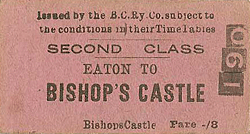 |
The station consisted of a single 95ft platform on the down side of the line, north of the level crossing. This was one of two level crossings on the line, the other being at Horderley. The stationmaster's – or more accurately stationmistress’s - bungalow stood some distance behind the platform. It was a small red brick T-shaped building with a hipped slate roof; one gable |
end faced the platform and the other two faced the road. A bay window overlooked the platform. An open-fronted waiting shelter, with an overhanging canopy and an adjacent ticket office, was attached to the north end of the building - which was very similar to that at Horderley.
There was a short siding on the down side at the north end of the station, running up to the end of the platform. There was no signal box; instead there was a ground frame at the south end of the platform controlling both the level crossing and access to the small yard. The station had only basic goods facilities and did not handle livestock.
Eaton had no stationmaster but was looked after by Mrs Annie Bason, a stationmistress of character who, if there were no waiting passengers, would signal the train through at walking pace. Newspapers and packets would be thrown out onto the platform while any more fragile parcels would be carefully lobbed into Mrs Bason's outstretched skirt!
BRIEF HISTORY OF THE BISHOP'S CASTLE RAILWAY
In 1860 a railway to link Bishop's Castle with Craven Arms was first mooted when a group of local tradesmen devised a plan for an 18½-mile single-track line to run from the Shrewsbury and Hereford line at Craven Arms to join the Oswestry & Newtown Railway (later to become the Cambrian Railway) near Montgomery, with a short branch to Bishop’s Castle. Plans for the line were deposited at Shire Hall, Shrewsbury, and the entire route was surveyed later that year. The Bishop's Castle Railway Company (BCR) was established in June 1861, and the following month the company received Royal Assent for the construction of their line.
| The southern end was to be built and opened first, running from Craven Arms (where the company had running powers over the main line as far as the junction at Stretford Bridge) to Lydham Heath, where there was a junction with the short branch to Bishop’s Castle. The remaining section of the line north from Lydham Heath to Montgomery would be completed at |
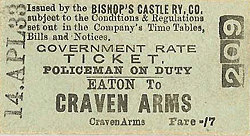 |
a later date.
Further surveys were completed early in 1862, and the company started to purchase land prior to construction. Oswestry-based contractor Thomas Savin was hired to build the railway; in his career Savin built at least ten different railways in Wales and the border area. Having taken an advance payment of £20,500, construction started in March 1863 but ground to a halt almost immediately as Savin was in financial difficulties. This was a gloomy portent of what was to come, and the company was forced to pursue its contractor into Chancery in the summer of 1864. Thomas Savin eventually declared himself bankrupt in February 1866.
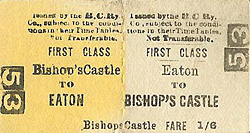 |
A new contractor, G M Morris of Plowden, was appointed, and work was finally under way again in October 1864. Morris did a good and thorough job, even building the line and bridges wide enough to accommodate double tracks in case of later expansion. Although this never happened, the BCR board were so buoyed up with future prospects that a |
second Act, The Bishop’s Castle Railway (Deviations) Act, was obtained in 1865. This authorised a further branch from Chirbury on the BCR to Minsterley which would give more direct access to Shrewsbury.
By October 1865 the 9½-mile section from Stretford Bridge, where the line made a junction with the S & H a little north of Craven Arms, to Lydham Heath and the ‘branch’ to Bishop’s Castle itself was complete. The planned triangular junction at Lydham Heath had not been built (and never was due to lack of funds) and there was only a north-facing junction which meant that all trains stopped at Lydham Heath, where the locomotive had to run round the train before completing its journey to Bishop’s Castle.
Despite these awkward junction arrangements the company decided to open the line to passenger traffic immediately, before Bishop's Castle station had even been built, and without waiting for the Board of Trade inspection - which was a legal requirement. The formal opening was on Tuesday 24 October 1865, when a large crowd gathered at Bishop's Castle to see a locomotive and 11 coaches, probably borrowed from the Mid-Wales Railway for the occasion, and laden with shareholders.
| The Board of Trade inspection eventually took place on 13 December 1865, and Colonel Yolland refused to authorise the opening of the line, much to the surprise of the company. The required improvements were made and, after a second inspection, the line finally opened to passengers on 1 February 1866. Intermediate stations were provided at Eaton, Plowden |
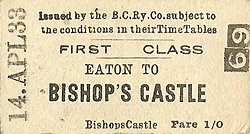 |
and Horderley; it is unclear if these stations actually opened with the line. A further station at Stretford Bridge, close to the junction with the Shrewsbury & Hereford (LNWR & GWR Joint from 1870) opened in 1890. There were four trains a day in each direction with the fastest journey time of 30 minutes. Some trains, however, took up to 50 minutes, running at an average speed of 12 mph!
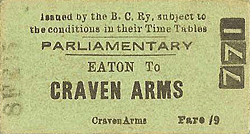 |
From the start passenger traffic was light and never improved apart from excursions to local football clubs, which were a regular occurrence, or the annual Shrewsbury Floral Fete. With disappointing passenger receipts, it was inevitable that the line would soon be in financial difficulty. This was exacerbated by the collapse of the Overend, Gurney & Co Bank in |
London with debts totalling £11m. Many small railway companies with lines under construction were badly hit, including the Bishop’s Castle. The two extensions to Montgomery and Minsterley were scrapped, but this was not sufficient to save the line which was now close to bankruptcy.
By the end of the first year the infant railway was bankrupt. From that time the company’s long life under the receiver began. Not for the last time bailiffs descended on the line and, while the train service was allowed to continue under supervision, most of the assets were seized and offered for sale by auction at the George Hotel in Shrewsbury on 23 January 1867. The total sum realised by the 61 lots was £3,522, the Midland Waggon Company, being the principal purchaser. Although the creditors were paid, the Bishop's Castle Railway remained in permanent receivership.
The total sum realised by the 61 lots was £3,522; the Midland Waggon Company, being the principal purchaser. Although the creditors were paid, the Bishop's Castle Railway remained in permanent receivership.
Despite its shaky start, the Midland Waggon Co. and the debenture shareholders were convinced of the line's potential and were content for it to continue to operate under the receiver. Following the auction the rolling stock was immediately leased back to the BCR.
| During the next decade local people believed that the receiver did not always act in the best interests of the line. Further land was seized in 1867, and in 1869 the Railway Clearing House emerged as another Bishop’s Castle creditor. The RCH obtained a judgement against the Bishop’s Castle for £621 4s 9d, principally on through traffic with GW/LNW. The judgement |
13.gif) |
having been obtained the matter was placed in the hands of a Sheriff who, however, could find no further property to seize. The Bishop’s Castle receiver was curiously impervious to any demands for money, it would seem, and the line continued to operate strangely immune to judgment or regulation.
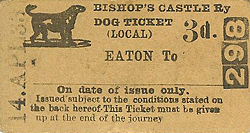 |
The line was to become notorious for its closures, and the most celebrated came in February 1887 when the widow of Dr. Frank Beddoes claimed that her husband was never paid for land sold to the BCR prior to construction. During his lifetime Beddoes had never bothered to pursue the company for payment, taking the broad view that the railway was a public |
convenience and the loss to him of a few acres of land was of little consequence. After Beddoes death, his wife took a different view and pressed for the money, eventually taking the company to court for the £800 that had never been paid. She won her case and, when the outstanding debt was not settled by the BCR, bailiffs were called in.
The bailiffs swooped on the railway near Horderley: workmen took out a couple of rails and built a fence across the track, blocking it and cutting off the rest of the line from the railway network. The bailiffs then sat down on the embankment and awaited developments. The impasse continued for about a week with residents of Bishop's Castle having to pay exorbitant prices for coal and other supplies brought in by road. To make matters worse, there were also a lot of LNWR wagons blocked in. The passenger service continued, however, with a shuttle operating between Bishop's Castle and Horderley, where passengers transferred to horse-drawn coaches to take them to Craven Arms.
| Local people were up in arms and a secret 'council of war' was formed at the Craven Arms Inn. The ‘council’ came up with an audacious plan, and wagons at Craven Arms were loaded with supplies destined for Bishop's Castle. In the meantime, a couple of men had crossed the line near Horderley, where the bailiffs were still keeping watch over the severed line and took pity |
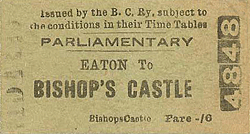 |
on them for their cold and lonely job. The visitors suggested a drink at the village pub, the Lion Inn, and the bailiffs readily agreed believing there was no chance of anyone trying to reinstate the line at that time of night. A gallon or two of mulled beer, tempered with a drop of gin, was served in front of the blazing fire. This seemed to suit the bailiffs better than keeping watch on a cold night. In the meantime a gang of men had placed the rails back in position and, soon after, an engine with all the empties crept quietly down from Bishop’s Castle into Craven Arms, picked up a train load of goods and coal, and steamed off at full speed towards the beleaguered town. By this time the bailiffs had recovered a little, in fact, sufficiently so to hear the engine. They ran out of ‘The Lion' shouting and trying in vain to stop the train as it sped by. They had been outwitted, and the goods and coal were safely unloaded at Bishop’s Castle. The lawyers threatened the manager with arrest, but he was able to prove an alibi.
After this incident the Bishop’s Castle Railway was allowed to continue to operate although the first mutterings against the management of the receiver were beginning to be heard. A takeover by the GWR was suggested together with the revival of the original aims to open through to Montgomery. The problem of the Beddoes’ land was solved through a rental arrangement, and another `celebratory (re)opening’ took place on 2 July 1877.
Further threats to the railway arrived at frequent intervals. It was peculiarly vulnerable, of course, through its odd legal position; inheritors of the shares and interest and debts incurred from the 1860s did not look on the line as compassionately as their fathers. Court cases, and the threat of them, were ever present.
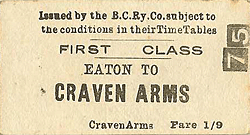 |
From 1891 the line began to make a small profit. Initially this was around £700 but by 1902 it had risen to £2000, according to Ludlow's MP (Robert) Jasper More. By February 1903 cutting the first sod of the line to Montgomery was confidently expected, as the project had received enthusiastic support from Jasper More. Extension to Montgomery, including the |
purchase of the Bishop’s Castle, was being actively discussed by the MP in London, though a more attractive alternative had surfaced. Suggested by the Reverend Prebendary White, vicar of Church Stoke, this envisaged a continuation from Lydham to Montgomery but via Kerry and Newtown.
On 13 March 1903 it was revealed that all litigation was at last at an end, and the Bishop’s Castle Railway, now free of legal entanglement, was already the object of a ‘syndicate sitting in London'. It would purchase the line and extend it either to Montgomery, to Welshpool or to Newtown (via Kerry). Great things were predicted. However Jasper More died at the end of November 1903, and this signalled an end to much of the active campaigning for extension of the line; his indefatigable effort to promote the prosperity of the district was also at an end.
| The spectre of the courtroom returned, and the Bishop’s Castle Railway 'Defence Trust' was established in 1904. How it operated is unclear, but local worthies seem to have clubbed together to cover whatever debts were in question. Further ideas for extension on to Montgomery were revived about 1912, sparked by the notion of Government grants, |
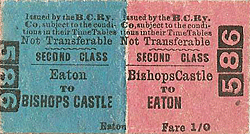 |
but this came to nothing although talk of the extension staggered on through the early 1920s; the Great Western sensibly fended off a recommendation by the Council that it should take an interest in the ‘direct Montgomery’ route. By this time the service had been reduced to three trains a day in each direction.
The Bishop’s Castle Railway was still bankrupt and unwanted and as such would probably have 'gummed up the works' of the Grouping Bill. It therefore remained independent at the establishment of the 'Big Four' in 1923. The Grouping seemed to render the Bishop’s Castle even more of an anachronism long before the next closure crisis, in 1930/31.
In the House of Commons the new Ludlow MP, Col. Windsor Clive, asked the Minister of Transport, Herbert Morrison, if he proposed to take any action on a resolution of Bishop’s Castle Borough Council that the Great Western should take over the line. Having already consulted with the GWR, Morrison stated that upon ‘careful consideration’ he did not propose to promote legislation for the compulsory transfer of the railway.
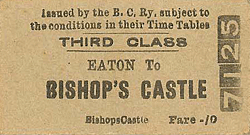 |
The ‘Bishop’s Castle Railway Users’ Committee’ emerged in 1931 following an unsuccessful attempt to secure a Government grant. It was presumably the lineal descendent of the ‘Defence Scheme' and the 'Defence Trust' and, though it was not a group of wealthy benefactors, it was able to put some pressure on the receiver/manager. By 1933 the Committee had |
disbanded although
The Defence Trust was still in existence, presiding over dwindling funds.
By now, the closure threat had become perennial, and all suggestions of extensions to Montgomery or elsewhere had been forgotten. In May 1933 the council expressed ‘the profoundest apprehension and dismay’ at the latest threatened closure stating it would raise the price of all the necessities of life, inevitably cause further unemployment, handicap farming locally, possibly kill off altogether the local cattle market and bring further rural depopulation.
Through all the threats and upsets, closure was stalking the line throughout its life, but there was always hope - almost an assumption - that somehow things would work out. From the early 1930s this changed, and a feeling of inevitable finality, a resignation to closure, took hold.
| The last two or three years had a ‘death row’ quality about them with regular appeals and reprieves, each less convincing than the last. Any profit had long vanished, and a Master in Chancery ordered the closing of the railway. Oddly enough it seems to have been the final decision of the Defence Trust as all funds were now exhausted and the trustees could do nothing |
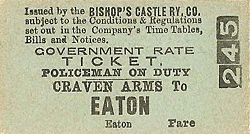 |
but withdraw the receiver. This they duly did on 8 April, to be later confirmed by the Master of Chancery. The end for both passenger and freight traffic was fixed for Saturday 20 April 1935. Rural bus services had started in 1900, and it was road transport that eventually dealt the railway its death blow.
The final demolition train left the line at Stretford Bridge Junction on 21 February 1937. Most of the rails went as scrap metal to Birkenhead where they were used by the Cammell Laird shipyard in the construction of HMS Prince of Wales. So effectively a piece of the Bishop's Castle Railway lies to this day on the bed of the South China Sea!
The easternmost stretch of line has been incorporated into the Onny Trail, forming a walk along the banks of the River Onny and across the fields where passengers stepped down to pick mushrooms. The course of the line is clearly visible today, well demarcated and forms a broad grassy walkway through sheep pasture or woodland trackway.
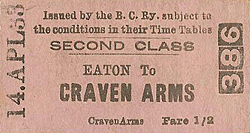 |
The Bishop's Castle Railway Society was formed in 1988 in response to interest generated by an exhibition held by The Bishop's Castle Local History Society. Members seek to obtain artifacts, document recollections and generally preserve the history of the Bishop's Castle Railway. The Society's museum is located in School Lane off the High Street Bishop’s |
Castle. Opening times are: Saturday and Sundays 14.00 hrs – 17.00 hrs from Easter to the end of September.
Tickets from Michael Stewart. except 90 Brian Halford. Bradshaws from Chris Totty. Route maps drawn by Alan Young.
Sources:
Further reading and other web sites:
|

old1.jpg)

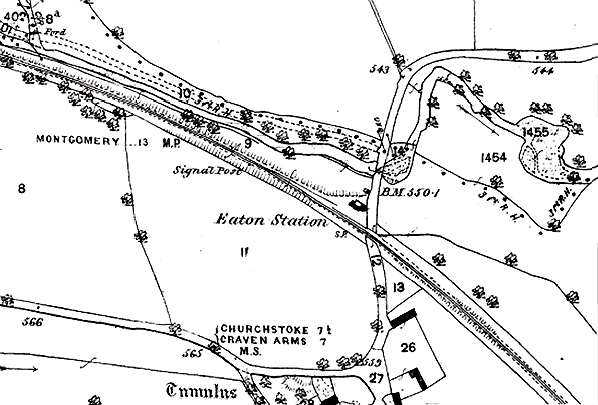
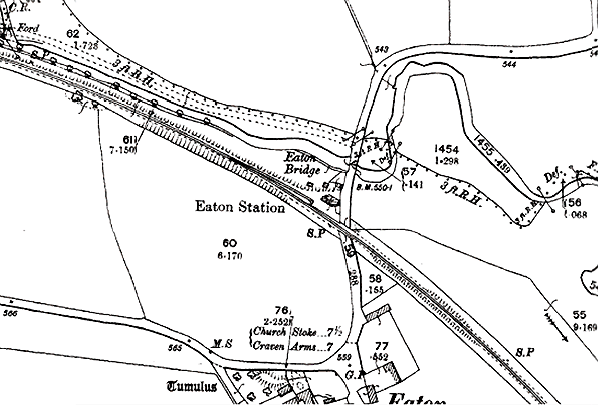
old3.jpg)
old6.jpg)
old9.jpg)
old7.jpg)
old8.jpg)
old4.jpg)
old5.jpg)
old2.jpg)
1.jpg)
2.jpg)
13.jpg)
8.jpg)



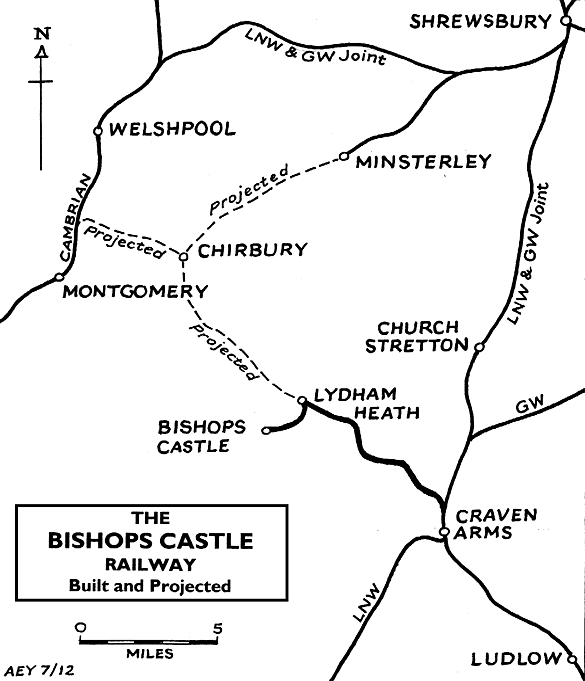



13.gif)









old_thumb10.jpg)
thumb3.jpg)
thumb5.jpg)
thumb6.jpg)
thumb16.jpg)
thumb7.jpg)
thumb10.jpg)
thumb9.jpg)
thumb12.jpg)
thumb4.jpg)
thumb14.jpg)
thumb11.jpg)
thumb15.jpg)

 Home Page
Home Page